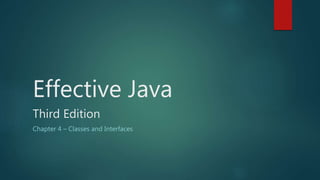The document discusses favoring composition over inheritance when extending classes. It provides an example of how inheritance can break encapsulation and cause unexpected behavior when the superclass changes. Instead, it recommends using composition by having the new class hold a private field for an instance of the existing class. This avoids issues caused by inheritance and allows the new class to delegate method calls to the wrapped instance of the existing class. The document also provides guidelines for when inheritance may be appropriate and stresses the importance of documenting how inheritance is intended to be used.






![Item 15: Minimize the accessibility of
classes and members
It is wrong for a class to have a public static final array field, or an accessor that
returns such afield.
public class A {
public final static Thing[] VALUES = {...};
}
public class A {
private final static Thing[] VALUES = {...};
public static final Thing[] values() {
return VALUES;
}
}
WRONG! Security hole!,
public class A {
private final static Thing[] PRIVATE_VALUES = {...};
public static final List<Thing> values() {
return Collections
.unmodifiableList(
Arrays.asList(PRIVATE_VALUES));
}
public static final Thing[] values() {
return PRIVATE_VALUES.clone();
}
}](https://image.slidesharecdn.com/effective-java-3rd-edition-ch4-200523141109/85/Effective-java-3rd-edition-ch4-7-320.jpg)















![Item 18: Favor composition over
inheritance
// Wrapper class - uses composition in place of inheritance
public class InstrumentedSet<E> extends ForwardingSet<E> {
private int addCount = 0;
public InstrumentedSet(Set<E> s) {
super(s);
}
@Override public boolean add(E e) {
addCount++;
return super.add(e);
}
@Override public boolean addAll(Collection<? extends E> c) {
addCount += c.size();
return super.addAll(c);
}
public int getAddCount() {
return addCount;
}
}
// Reusable forwarding class
public class ForwardingSet<E> implements Set<E> {
private final Set<E> s;
public ForwardingSet(Set<E> s) { this.s = s; }
public void clear() { s.clear(); }
public boolean contains(Object o) { return s.contains(o); }
public boolean isEmpty() { return s.isEmpty(); }
public int size() { return s.size(); }
public Iterator<E> iterator() { return s.iterator(); }
public boolean add(E e) { return s.add(e); }
public boolean remove(Object o) { return s.remove(o); }
public boolean containsAll(Collection<?> c)
{ return s.containsAll(c); }
public boolean addAll(Collection<? extends E> c)
{ return s.addAll(c); }
public boolean removeAll(Collection<?> c)
{ return s.removeAll(c); }
public boolean retainAll(Collection<?> c)
{ return s.retainAll(c); }
public Object[] toArray() { return s.toArray(); }
public <T> T[] toArray(T[] a) { return s.toArray(a); }
@Override public boolean equals(Object o)
{ return s.equals(o); }
@Override public int hashCode() { return s.hashCode(); }
@Override public String toString() { return s.toString(); }
}
composition-and-forwarding approach](https://image.slidesharecdn.com/effective-java-3rd-edition-ch4-200523141109/85/Effective-java-3rd-edition-ch4-23-320.jpg)




![Item 19: Design and document for
inheritance or else prohibit it
Constructors must not invoke overridable methods, directly or indirectly.
public class Super {
// Broken - constructor invokes
an overridable method
public Super() {
overrideMe();
}
public void overrideMe() {
}
}
public final class Sub extends Super {
// Blank final, set by constructor
private final Instant instant;
Sub() {
instant = Instant.now();
}
// Overriding method invoked by
superclass constructor
@Override public void overrideMe() {
System.out.println(instant);
}
}
public static void main(String[] args) {
Sub sub = new Sub(); // null
sub.overrideMe(); // 2020-05-03T08:31:15.449012300Z
}](https://image.slidesharecdn.com/effective-java-3rd-edition-ch4-200523141109/85/Effective-java-3rd-edition-ch4-28-320.jpg)




















